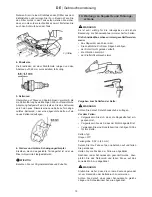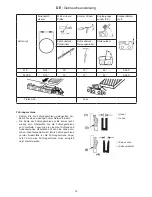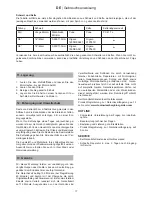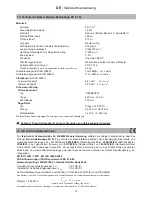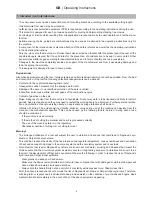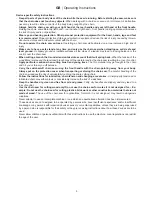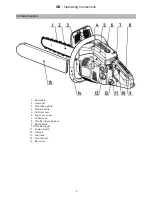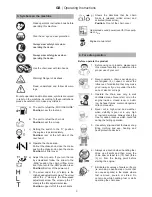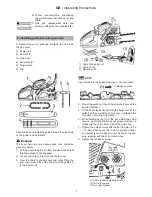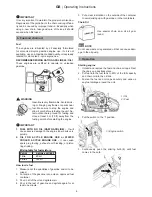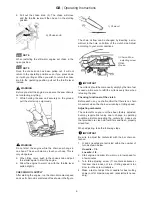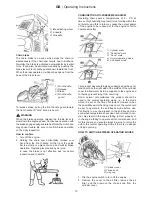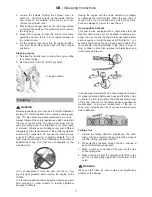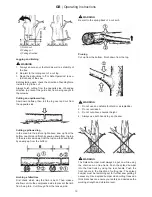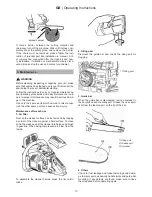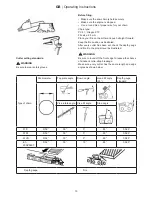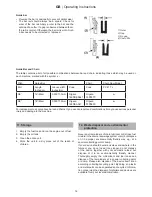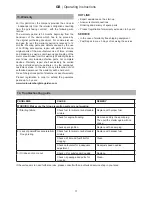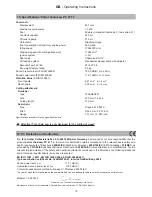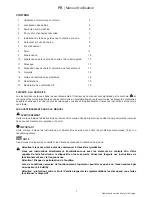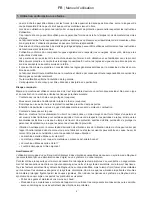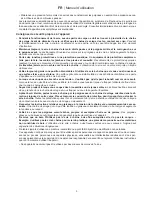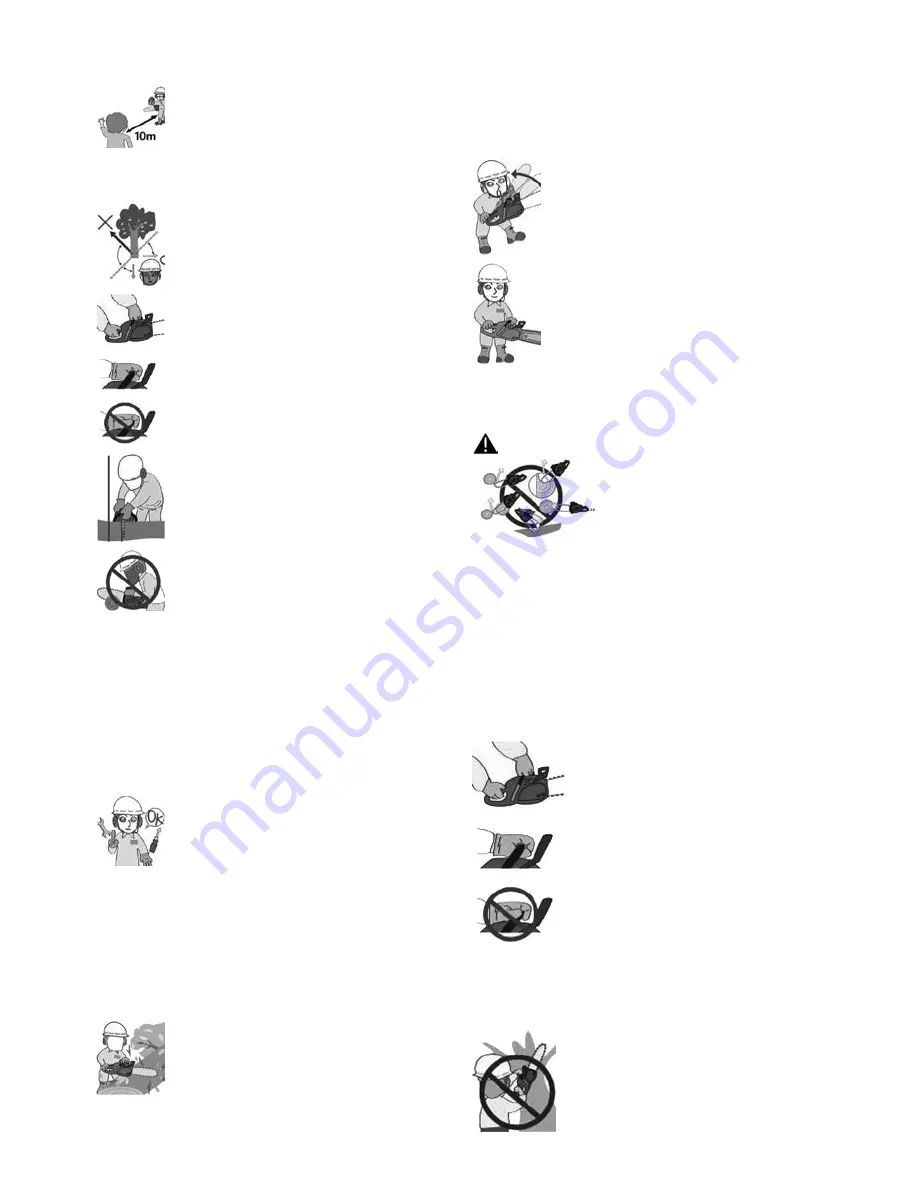
GB
| Operating Instructions
6
8. Do not allow other persons to be near
the chain saw when starting the engine
or cutting a wood. Keep bystanders and
animals out of the work area. Children,
pets, and bystanders should be a mini-
mum of 30 feet (10m) away when you
start or operate the chain saw.
9. Never start cutting until you have a clear
work area, secure footing, and planned
retreat path from the falling tree.
10.
Always hold the chain saw firmly with
both hands when the engine is running.
Use a firm grip with thumb and fingers
encircling the chain saw handles.
11. Keep all parts of your body away from
the saw chain when the engine is run-
ning. Before you start the engine, make
sure the saw chain is not contacting
anything.
12. Always carry the chain saw with the
engine stopped, the guide bar and saw
chain to the rear, and the muffler away
from your body. When using a vehicle to
transport the machine, position it so that
it can cause no danger to persons and
fasten it firmly.
13. Always inspect the chain saw before
each use for worn, loose, or changed
parts. Never operate a chain saw that
is damaged, improperly adjusted, or is
not completely and securely assem-
bled. Be sure that the saw chain stops
moving when the throttle control trigger
is released.
14. All chain saw service, other than the
items listed in the Operator’s Manual,
should be performed by competent
chain saw service personnel. (e.g., if
improper tools are used to remove the
flywheel, or if an improper tool is used
to hold the flywheel in order to remove
the clutch, structural damage to the
flywheel could occur which could sub
-
sequently cause the flywheel to disin
-
tegrate).
15. Always shut off the engine before set-
ting it down.
16. Use extreme caution when cutting small
size brush and saplings because slen-
der material may catch the saw chain
and be whipped toward you or pull you
off balance.
17. When cutting a limb that is under ten-
sion, be alert for spring back so that
you will not be struck when the tension
in the wood fibers is released.
18. Keep the handles dry, clean and free of
oil or fuel mixture.
19. Guard against kickback. Kickback is the
upward motion of the guide bar which
occurs when the saw chain at the nose
of the guide bar contacts an object.
Kickback can lead to dangerous loss of
control of the chain saw.
20. When transporting your chain saw,
make sure the appropriate guide bar
scabbard is in place. Securely place the
machine and tighten the cap of oil and
fuel tank during transport to prevent loss
of fuel, damage or injury.
KICKBACK SAFETY PRECAUTIONS FOR CHAIN
SAW USERS
WARNING
Kickback may occur when the
nose or tip of the guide bar touch-
es an object, or when the wood
closes in and pinches the saw
chain in the cut.
Tip contact in some cases may cause a lightning fast
reverse reaction, kicking the guide bar up and back
towards the operator. Pinching the saw chain along
the top of the guide bar may push the guide bar rapidly
back towards the operator. Either of these reactions may
cause you to lose control of the saw which could result
in serious personal injury.
• Do not rely exclusively on the safety devices built
into your saw. As a chain saw user you should take
several steps to keep cutting jobs free from accident
or injury.
1)
With a basic understanding of kick-
back you can reduce or eliminate the
element of surprise. Sudden surprise
contributes to accidents.
2)
Keep a good grip on the saw with
both hands, the right hand on the
rear handle, and the left hand on the
front handle, when the engine is run-
ning. Use a firm grip with thumbs and
fingers encircling the chain saw han
-
dles. A firm grip will help you reduce
kickback and maintain control of the
saw. Don’t let go.
3)
Make certain that the area in which
you’re cutting is free from obstruc-
tions. Do not let the nose of the guide
bar contact a log, branch, or any other
obstruction which could be hit while
you are operating the saw.
4)
Cut at high engine speeds.
5)
Do not overreach or cut above shoul-
der height.
Summary of Contents for PC 41 TL
Page 2: ......
Page 78: ...1 RU 1 2 2 4 3 5 4 5 5 6 6 8 7 8 8 11 9 13 10 15 11 17 12 17 13 17 14 18 15 19 16 19 80 dB A...
Page 79: ...2 RU 1...
Page 80: ...3 RU...
Page 81: ...4 RU 2 1 2 3 4 5 6 7 8 9 10 11 12 13 14 15...
Page 82: ...5 RU f H L g LWA 4 1 2 3 4 5 6 10 3 3 a MIX GASOLINE b c O d e MAX MIN...
Page 83: ...6 RU 7 8 30 10 9 10 11 12 13 14 15 16 17 18 19 20 1 2...
Page 84: ...7 RU 3 4 5 6 7 5 1 2 3 4 5 6 1 2 3 1 2 3 1 4 5 6 2 3...
Page 85: ...8 RU 6 7 12 15 Nm 8 6 40 1 3 10 1 2 4 2 40 1 1 25 5 125 1 2 3 4 5 7 1 2 80 3 1 2...
Page 86: ...9 RU 4 I 3 5 4 6 5 5 7 8 9 1 1 1 2 3...
Page 87: ...10 RU 1 H L H 1 4 L 1 4 2 1 2 L 3 H 4 T 5 H 1 2 3 4 1 2 0 5 C...
Page 88: ...11 RU 1 2 Sunshine 3 Snow a b 1 2 3 1 2 3 4 5 snow 6 1 2 O 1 8...
Page 89: ...12 RU 1 2 1 2 3 4 1 2 3 1 2 3 A B...
Page 90: ...13 RU 1 2 3 4 1 2 3 4 9 1...
Page 91: ...14 RU 2 1 3 1 2 3 4 1...
Page 92: ...15 RU 2 a 1 b 3 2 4 0 65 mm Champion RCJ7Y 5 6 10...
Page 95: ...18 RU 14 1 2 3 Ko 5 7...
Page 157: ......
Page 159: ......





